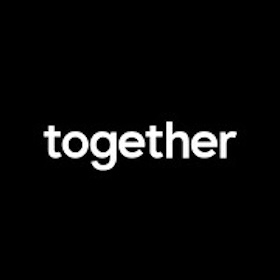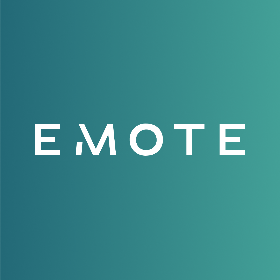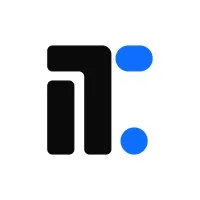
2025 Marketing Agency Industry Trends: Exclusive data from 220+ leaders
Every year comes with marketing predictions, but this year feels a little… different. With Generative AI reshaping search, budgets under tighter scrutiny, and clients demanding results faster than ever, agency life isn’t business as usual.
To get a clear picture of where things stand, AgencyAnalytics surveyed 220+ agency leaders across the US, Canada, UK, New Zealand, and Australia. The result is the 2025 Marketing Agency Benchmarks Report, now in its fourth edition. The findings are eye-opening and validating, showing exactly how agencies are using AI, keeping up with drastic algorithm updates, and powering through the day-to-day grind.
If you’re unfamiliar, AgencyAnalytics is the all-in-one reporting platform built for marketing agencies, helping 7000+ teams streamline client reporting, automate data collection across 80+ integrations, and win back billable time. With that unique vantage point, this report expands on real challenges and wins from agencies on the ground, not generic insights.
The full Marketing Agency Benchmarks Report dives deep into the data, but to give you a taste of what it contains, here are seven top takeaways and what they mean for agencies like yours.
1. 73% of leaders agree that Generative AI has radically transformed the search landscape
Search today looks nothing like it did a year ago. With Google’s AI Overviews and conversational search, users often get the answers they need without clicking through to a website. It’s no surprise, then, that 73% of agency leaders say AI has fundamentally disrupted SEO.

That means traditional SEO tactics alone are no longer enough. As users stop at AI-generated summaries, success increasingly depends on formats that satisfy intent quickly, like Q&As, explainers, and structured data.
2. Paid advertising is taking the driver’s seat
In light of these shifts in organic search, agencies are rethinking their service mix. In fact, 68% of leaders predict that paid advertising will be the most effective channel in 2025.

Here’s another interesting stat from the report: 89% of agency leaders now rank PPC as their core offering. Just a year ago, SEO & Web Design was the top service, making this pivot toward paid media even more pronounced.
This doesn’t mark the end of SEO, as it absolutely remains a vital channel for long-term visibility and authority. However, the balance has shifted, and the data clearly shows that agencies are recalibrating their strategies.
3. The two sides of the AI coin: Increased efficiency and unfamiliar challenges
AI is delivering real gains–most surveyed agencies (58%) have faster content creation workflows because of it. However, those efficiencies also come with new hurdles and uncharted territory. Consider that:
- 57% of agencies observed greater content saturation, noting that crowded SERPs make it harder than ever to break through.
- 50% point to Google’s constant algorithm updates, which keep SEO strategies in flux and require continuous adjustments.
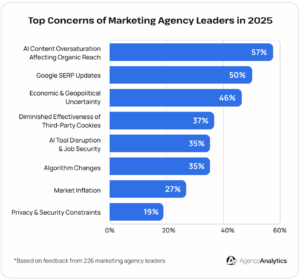
It’s safe to say that AI has outgrown the experimentation stage—it’s now woven into everyday workflows. So, the question isn’t if agencies will use AI, but how they’ll reengineer their operations around it.
Wondering if most agencies are considering structural changes or already carving out dedicated AI specialist roles? Download the free in-depth Marketing Agency Benchmarks Report to find out.
4. So far, Instagram shows no signs of slowing down
When asked where budgets are likely to grow, 65% of leaders picked Instagram for the second year in a row. The platform’s mix of short-form video and visual-first storytelling keeps things engaging, especially for B2C brands in lifestyle, fashion, or beauty.
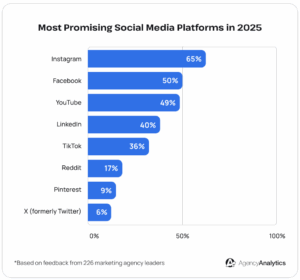
Interestingly, though, some agencies expect influencer marketing to decline. With AI blurring the line between ‘real’ and fabricated, many clients are chasing authenticity, preferring micro-content and brand storytelling over one-off influencer deals.
It shows that there’s still tremendous value in human creativity and lived experience–qualities that machines can’t replicate.
5. Strong relationships are the top driver of client retention
Speaking of human connection, retention boils down to one steady factor: Solid agency-client relationships. That’s why 81% say it’s the top driver of loyalty, even ahead of campaign performance (49%).
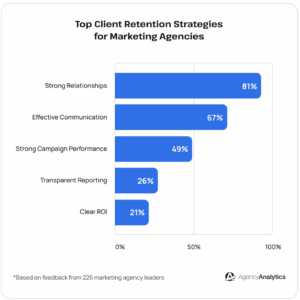
It’s not to say those other factors don’t matter. After all, clients still need to see solid results and how their dollars are being spent. That said, building a strong rapport and showing genuine interest in client needs pays off, especially in the long run.
6. Reporting ranked “extremely important” by 7 in 10 agency leaders
Strong client relationships may build trust, but it’s transparent reporting that keeps it intact. In fact, 70% of agency leaders agree that reporting is “extremely important” for retention.
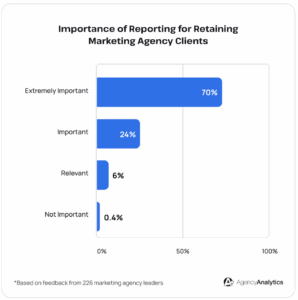
Done right, reporting goes far beyond spreadsheets and dashboards. It connects performance to business goals, tangibly shows your agency’s impact, and sparks strategic conversations that deepen partnerships.
When clients understand results and the story behind them, they’re more likely to stay engaged and committed. To ensure you’re not bogged down by manual reporting woes or data glitches, it’s a good idea to invest in a dedicated client reporting tool like AgencyAnalytics.
7. Client acquisition remains the toughest growth hurdle
34% of leaders cite new client acquisition as their biggest pain point, and for good reason.
Winning a client takes more than a polished proposal. It’s the culmination of research, discovery calls, tailored pitches, and relentless follow-ups, all without any guarantee of success.

Agencies have their work cut out for them. However, with sharper positioning, consistent relationship-building, and a clear value story, there’s a real opportunity to turn hard-won prospects into long-term clients.
8. Agencies primarily use Net 30 terms, with a preference for credit card payments
When it comes to billing, simplicity rules. 86% of agencies accept credit cards, favoring speed and convenience for both sides. Nearly half (47%) default to Net 30 terms (i.e., payment due in 30 days), giving clients a fair window to settle invoices.

Interestingly, the detailed findings show that most agencies aren’t leaning on payment incentives as a growth lever. This suggests that agencies know the value of their services and prefer to stand firm on pricing, flexing only when it makes strategic sense.
The bottom line: Agencies are continuously adapting to keep the ball rolling
The 2025 Marketing Agency Benchmarks Report makes one thing clear—agencies are operating in a much different landscape than a year ago.
Despite the upheaval, most leaders aren’t backing down. Instead, they’re actively learning about new SEO realities, navigating an AI-first environment, and reshaping service offerings to meet client needs. Therefore, those who are willing to embrace change today will be the ones positioned for success in 2026 and beyond.
Want to dive deeper into 30+ data-driven insights from agency leaders, including the top client-requested services, strategies for adapting to Gen AI, what agencies do when payments are late, and the #1 source for new business? Download the full report today.



